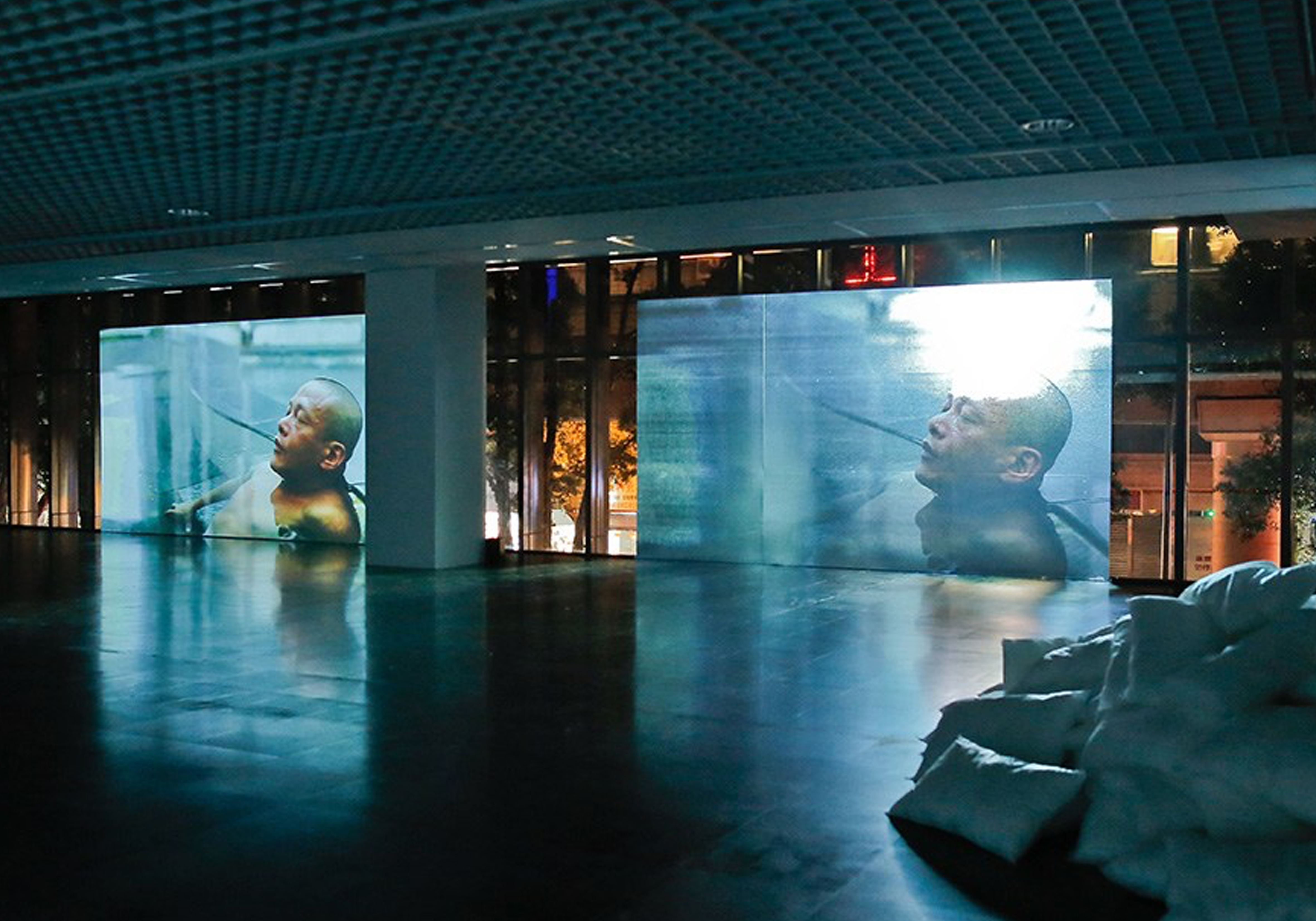本展播放三部短片皆為蔡明亮近兩年全新創作。《西遊》與《無無眠》是「行者」系列短片的第六與第七部作品,李康生身穿紅色僧袍、光頭赤腳,以其獨特緩慢的速度行走在世界各地,彰顯一種失落已久的──唐朝玄奘徒步萬里西行取經的弘法精神。《秋日》是黑澤明御用場記、同時也身兼作家及製片人—野上照代女士的肖像錄。 本展覽採用極簡無裝置概念,讓影片作品中的城市影像和美術館原有的展場空間,在夜晚氛圍下緊密結合,並選用不同材料作為投影介質,紙糊屏幕的細微紋路與斑駁痕跡;金屬板如同賽璐璐般的通透質感,皆產生了不同的投影及觀看效果。為期四週的展覽舉辦了多場深夜講堂、音樂會及夜宿美術館活動,吸引眾多學生、民眾甚至親子家庭走進美術館,拓展了藝術參與及美感體驗的更多可能。
The three short films screened in the exhibition were TSAI Ming-Liang's latest works in two years. Journey to the West and No No Sleep are the 6th and 7th films in the Walking Series. LEE Kang-Sheng was dressed in a red robe, head shaved and barefoot. He walked to different places around the world in his very own unique pace, manifesting a long-lost spirit of the Buddhist monk Xuanzang, who journeyed to the West for his pilgrimage and preaching journey in the Tang Dynasty. Autumn Days was a portrayal of Teruyo Nogami, who was Akira Kurosawa’s script supervisor as well as a writer and movie producer.
According to Tsai: “The curatorial concept of the exhibition remains minimalist without employing any special installations. I purposely constructed the impression that the city in the film was immersed in the exhibition hall in the atmosphere of the late night. I chose various kinds of materials as the projecting medium. The papered screen showed subtle lines and mottled traces, whereas the metal projection wall displayed a sense of transparency reminiscent of celluloid. Both made a tremendously different effect for projecting and viewing. During the four-week exhibition, we held a series of midnight lectures, concerts, and museum-sleep-over events, which appealed to many students, the public, and even parents and children. The exhibition expanded the participation in art making and created more possibilities to experience beauty.”
蔡明亮 TSAI Ming-Liang
1957年出生於馬來西亞,為台灣新電影運動以來最具代表性的電影導演之一。1994年以《愛情萬歲》奪下威尼斯金獅獎,奠定世界影壇地位,之後亦獲藝術界青睞,於台北、威尼斯、上海、名古屋等地推出展演及跨界創作。2009年作品《臉》成為羅浮宮首部典藏電影,創下藝術電影的標竿與典範。2012年展開「慢走長征」影像創作計劃,至今已完成七部短片作品。2013年憑《郊遊》獲威尼斯評審團大獎及金馬獎最佳導演。2014年受布魯塞爾、維也納、台北與光州等藝術節邀請,推出舞台劇《玄奘》;同年於臺北教育大學北師美術館展出《來美術館郊遊》,寫下電影走進美術館的歷史創舉。
Born in Malaysia in 1957, TSAI Ming-Liang is one of the most prominent film directors of the new cinema movement in Taiwan. In 1994, his film Vive L’ Amour was awarded the Golden Lion at the Venice Film Festival, and established his position in international filmdom. In recent years, TSAI has also moved on to installation art, and has his exhibitions and interdisciplinary works in Taipei, Venice, Shanghai, Nagoya, etc. In 2009, Face became the first film to be included in the collection of the Louvre Museum’s “Le Louvre s'offre aux cineastes,” setting the benchmark for films venturing into the world of art galleries. Since 2012, he has been working on a long project to film LEE Kang-Sheng's slow walk. To date, he has completed seven short films. In 2013, his latest full-length feature, "Stray Dogs," was awarded the Grand Jury Prize at the 70th Venice Film Festival and Best Director at the Gold Horse Awards. In 2014, he presented the critically acclaimed theater work, The Monk from Tang Dynasty, in arts festivals in Brussels, Vienna, and Taipei. That same year, TSAI made history by bringing his movie, Stray Dogs at the Museum, into the Museum of National Taipei University of Education (MoNTUE).
蔡明亮
蔡明亮、李天爵
王雲霖
張鍾元
戰爭藝術公司
林曼麗 執行總監|藍恭旭 展覽統籌|徐珮琳 展覽執行|吳家祺 媒體暨編輯|朱筱琪 教育推廣|趙宜恬 志工統籌│鍾一瑄 票務行銷|徐珮琳 行政專員│黃聖閎 展覽助理|王韞雄、林惠慈、洪紹元、莊舒茵、李宣
莊濟寰
國立臺北教育大學北師美術館
關鍵字
評審談作品
時間作為電影展覽的另一路徑,是引領觀眾走入展廳,坐臥躺觀賞動靜之間的聲影
入圍理由 Comments from Nomination Committee
繼「來美術館郊遊」後,「無無眠」再次進入北師美術館,以更為簡潔布展形態呈顯「行者」系列兩部影片與〈秋日〉。毫無疑問,時間仍為蔡明亮作品最核心的思想。它是玄奘的緩慢步走、是冬夜的踟躕、是浸泡水中的謐靜。光影幻化之間,投映銀幕與館外市景交融。時間作為電影展覽的另一路徑,是引領觀眾走入展廳,坐臥躺觀賞動靜之間的聲影。於此同時,「無無眠」的啟示在於將美術館形構為融會大眾文化(歌手獻唱)與嚴肅文化(電影作為藝術)的交匯之處,更成為觀眾的沉睡之穴。(主筆/孫松榮)
Since Stray Dogs at the Museum, No No Sleep once again comes to the Museum of National Taipei University of Education, and showcases two films, Walker and Autumn Days, in the form of a minimalistic exhibition. It goes without saying that time is still at the core of TSAI Ming-Liang's work. It manifests itself in the slow pace of the great monk from the Tang dynasty, in the hesitation of a winter night, and in the calmness of submerging under water. In the interplay of light and shadow, the projection screen and the cityscape outside the museum have become one. As another approach to such a cinematic exhibition, time guides the audience into the exhibition space and to appreciate the moving and still images sitting or lying down. In the meantime, No No Sleeptransforms the museum into a site where public culture (performances by singers) and serious culture (movie as a form of art) encounter and integrate, rendering it a den of slumber for the audience. (Commentator: SING Song-Yong)






